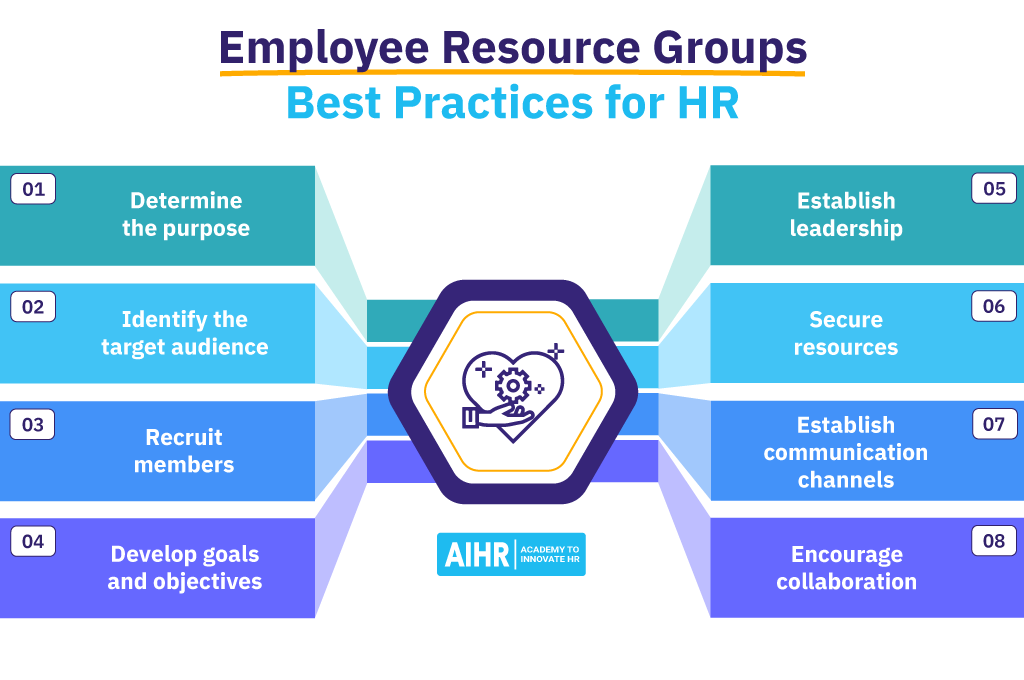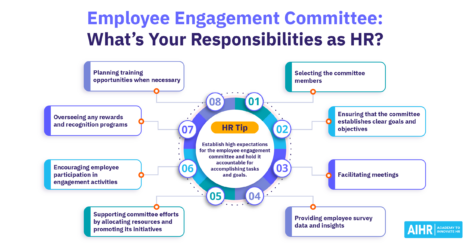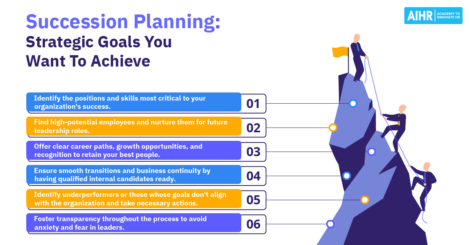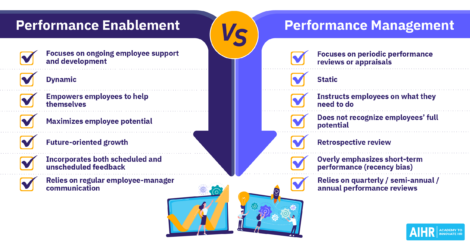Employee Resource Groups: Everything You Need To Know

Employee resource groups encourage belonging and camaraderie among colleagues who come together for a shared cause. These groups can be a powerful tool for meeting the needs of a diverse workforce by fostering an inclusive environment, giving employees official input, and granting more access to professional development.
This article will explore employee resource groups and recommend some best practices for HR professionals.
Contents
What are employee resource groups?
Employee resource groups vs affinity groups
Types of employee resource groups
Best practices for creating and managing employee resource groups
Employee resource groups examples
What are employee resource groups?
Employee resource groups (ERGs) are a way to connect employees who share particular interests, backgrounds, causes, or characteristics by bringing them together in the workplace. Providing a forum where people can share experiences and support each other in their personal and professional goals can lead to enhanced engagement with their jobs and the organization.
ERGs are meant to gather people together who have commonalities or might be underrepresented in company culture or policies. These voluntary, employee-led groups are important because they encourage belonging and build trust. When workers feel heard and accepted, they are empowered to voice fresh ideas and viewpoints that drive innovation.
Employee resource groups may function in the following ways:
- Show appreciation and acceptance of all employees and encourage an inclusive work environment.
- Cultivate stronger relationships among employees.
- Provide a safe situation for sharing concerns.
- Bring awareness to how workplace issues affect certain groups.
- Offer personal growth and professional development opportunities.
Why groups matter to people
Human behavior demonstrates an innate desire to rely on each other and form groups. We are born into families, we cultivate relationships, we join cultural, religious, and service organizations, and so on. Community is the construct for participating in life.
Human beings are drawn to each other because being a part of a group meets vital social and psychological needs, such as:
- Identity: We categorize ourselves by defined traits, interests, etc., and then feel validated by aligning with others who are similar.
- Belonging: We seek interpersonal relationships because they help us feel included instead of excluded and accepted not rejected.
- Membership: Through others, we get access to helpful information and assistance, as well as the reassurance of social support.
ERGs are one way to help meet employees’ need for human connection. Banding colleagues together helps them create bonds that support their well-being, making them more satisfied and capable of higher productivity.
Employee resource groups vs affinity groups
ERG groups and affinity groups are often confused with each other, but they have different purposes.
Affinity groups are informal gatherings where people unite to reinforce their similarities and network with each other. These employee-organized groups are not arranged by HR or incorporated into the organization’s business framework.
Employee resource groups are acknowledged by leadership and sponsored by HR, making them formally integrated into the organization. They focus on bringing broader awareness to the common interest and promoting the participants’ career advancement with networking and mentoring opportunities. ERGs can develop emerging talent and be a catalyst for solutions that reduce turnover within particular employee groups.
Benefits of employee resource groups
Employee resources groups have a great deal to offer employees and organizations because they can affect real change. ERGs can be credited with numerous benefits, such as the following:
For the organization:
- Future leader development: ERGs nurture talent by offering professional development through mentoring, workshops, and leadership training. Participants also have the opportunity to be identified as emerging leaders through networking with colleagues across the company whom they might not have otherwise crossed paths with.
- Talent attraction: Many job seekers are looking for an employer that values diversity. Providing resources for employees who want to align with others to honor their shared characteristics reflects an organization’s dedication to an inclusive work environment.
- Improved employee retention: When employees feel valued and supported, it builds a positive work culture. This leads to better engagement with their jobs and a stronger commitment to staying with the organization.
- Risk management: The safety of an ERG allows individuals to feel comfortable discussing troubling issues or situations with others instead of suppressing their frustrations. They may feel more comfortable voicing concerns to HR when they have the support of their group. Then HR can address the concerns before they turn into a full-blown conflict.
- DEI strategy input: The resource group members have first-hand experience with what the company culture is really like and which policies, programs, and activities need improvement. Their insights can provide valuable input into how DEI strategies are developed and adopted.
For employees:
- Personal connection and community: ERGs create a place where employees feel included and free to be themselves. They share experiences and build gratifying relationships that keep them from feeling isolated.
- Better work environment: Bonds formed through ERGs engage employees with each other and their roles. They can work together to form ideas, challenge the status quo, and promote initiatives that improve the overall atmosphere and physical comfort of the workplace.
- Career development: Learning and networking opportunities accessed through ERGs expand employees’ skills and give them access to new people and areas of the organization for more exposure to career advancement.
- Support and resources: ERG members have a safe avenue for discussing sensitive issues or addressing a problem they’re having. ERG leaders guide members through workplace challenges with tangible resources and emotional support. They can also assist in filing complaints with HR for unfair practices.
Types of employee resource groups
Employee resource groups are designed based on shared characteristics or common interests, such as ethnicity or religious affiliation. The focus of ERGs is often underrepresented employees, but they can grow out of wherever there is a need for community.
There are numerous types of employee resource groups found in different organizations based on the various populations of their workforces. Here’s a quick look at four kinds of ERGs:
1. Diversity and inclusion groups
DEIB is a predominant focus of ERGs. Diversity and inclusion groups bring in people who are in the minority based on features such as ethnicity/culture, gender/gender identity, disabilities, religious affiliation, or sexual orientation.
These ERGs build community and offer a welcoming environment for sharing experiences and ideas, as well as voicing concerns. Members can also provide input to leadership about what matters to this particular group of people and how to better design initiatives and respond to issues.
2. Professional development groups
People who want to improve their skills to pursue leadership or other career paths take part in professional development groups. These groups offer workshops, networking, and mentoring to help members expand their knowledge and abilities and stay up-to-date on trends in their field. They provide inspiration and direction for employees to pursue further education or certifications to increase their potential for career-advancing jobs.
Professional development ERGs can also be centered on giving employees exposure to specific areas across the business. They can form relationships with leaders and take part in special projects outside of their current scope of responsibility.
3. Health and wellness groups
Health and wellness ERGs get people together who have a common challenge or interest in this area. They allow employees to connect with others who face similar physical and mental health challenges for support. They can also foster awareness of certain physical or mental conditions to confront and reduce stigmas.
These ERGs can also originate to promote physical and mental health awareness for all employees and encourage a healthy company culture. They may offer up initiatives and solutions for the organization to sponsor within a wellness program.
4. Community service groups
Employees who find fulfillment through helping others can participate in community service groups. These ERGs find ways to do community outreach by providing assistance to local organizations and organizing volunteer opportunities for all employees. They may serve or deliver food, fund scholarships, tutor or mentor students, or provide labor for service projects.
Community service group members also act as ambassadors for the company. Their activities can be good for public relations, especially when the causes align with the values and mission of the organization.
Best practices for creating and managing employee resource groups
Although ERGs are employee-led, HR needs to set them up for success. Whether ERGs already exist within your organization or you’re starting the first one, there is much to consider.
We’ve put together the following best practices for launching and managing ERGs:
Determine the purpose
You must start with a clear understanding of what the point of the group will be. What needs will it fulfill, or challenges will it address? For example, will it cultivate DEI, expand professional development, promote health and wellness, or encourage community service? Having the group’s purpose at the forefront will keep it on track.
HR pro tip
Your organization should have an employee resource group policy that provides guidelines for the formation and management of ERGs. Such a policy will help align the groups with company values and objectives while promoting inclusion and transparency.
Identify the target audience
Consider who will want to participate in this ERG. Will it appeal to your organization’s larger demographics, or is it for a niche group? Depending on the situation, this could require some out-of-the-box thinking. Don’t let any bias set limits on the possibilities for the target audience. Identifying who the potential members might be can help you choose the right channels for promoting the resource group.
Recruit members
It’s fine for a group to start small and grow gradually. If you have someone in mind with ERG leadership potential, have them spearhead the member recruiting process. An employee who’s committed to the cause can help spread the word and approach people who may be interested in helping establish it. Colleagues may be motivated to join if they get to have a say in how the group will run and be marketed to others.
Develop goals and objectives
ERGs need a foundation and structure. Setting short and long-term goals ensures that the purpose of the resource group is known and accomplished and that there is accountability. These objectives need to be realistic and achievable within a particular time frame. Example ERG goals could be:
- Influence company policy-making to create a more welcoming work environment.
- Increase the number of professional certifications or job promotions obtained by women of color.
- Provide networking, mentoring, and career advancement opportunities for group members.
- Improve job satisfaction survey ratings among neurodiverse employees.
Quantifiable goals are easier to measure and prove they are being met. Metrics that can gauge success from the group’s efforts give more credibility. Additionally, ERGs need to monitor their goals and make adjustments if they shift over time.
Establish leadership
ERGs are all about empowering employees, and they are employee-run activities. Group members decide how the group is structured and facilitated. The inaugural members can brainstorm ideas, compose a mission statement, and vote on leaders to get the group started. Leaders must be receptive to feedback and provide ways for general members to have a voice and regularly contribute.
Secure resources
HR must support ERGs with what they need to get started and function on an ongoing basis. This typically means funding, physical resources, and tools. Allocating a budget for each group lets them decide what type of employee resource group activities and outreach they can plan.
Each group also needs consistent, comfortable accommodations for holding in-person meetings and activities, as well as the necessary digital tools for tracking their metrics and finances.
HR pro tip
Create an employee resource group toolkit to streamline ERG management within your organization. This comprehensive resource should cover all the aspects of establishing and sustaining ERGs. It will equip ERG leaders with the tools they need to drive meaningful change within your company.
Establish communication channels
Open dialogue and transparency about ERGs help employees understand that they’re available and keep them from being viewed as a type of secret society. Find ways to market the resource group to potential members and spread awareness to all employees. Communication channels to consider include:
- Online employee forums/bulletin boards
- Company newsletters
- Career page
- Social media
- Slack channels
- Onboarding materials
Encourage collaboration
The different ERGs within an organization should see each other as allies to lift up and collaborate with and not as competition. Periodic opportunities that bring representatives from every group together provide a forum for better understanding each group’s purpose, sharing ideas, and learning from each other’s experiences. Building relationships and joining forces with external ERGs can expand knowledge and influence. Group members should be encouraged to attend networking events and participate in professional associations.
ERGs can thrive even more when organization leaders invest in and advocate for them. They can act as coaches and mentors or get behind the ERG’s message when it comes to policy-making or transforming general attitudes.
Employee resource groups examples
The concept of employee resource groups is gaining momentum. ERGs are becoming the standard for many organizations, especially large corporations.
Here are examples of how four companies have implemented ERGs:
1. ITAA employee resource groups
Financial services company TIAA has 40% of their employees participating in 12 different ERGs that offer networking, leadership development, philanthropic endeavors, multicultural awareness, business solutions, and community outreach.
The ERGs are geared toward three separate nationality groups, people with disabilities, young and seasoned employees, women, the LGBTQ community, and military members/veterans and families. TIAA has won multiple awards for its commitment to DEI and for being a great place to work.
2. Siemens employee resource groups
Siemens, a global technology company, strives to support internal social networking with its 12 ERGs. One of these is the EMEA Champion ERG. It fosters diversity and inclusion throughout its European workforce with representatives and initiatives from each country. Another ERG at Siemens aims to cultivate career-minded administrative professionals with education and growth opportunities.
Siemens leaders believe that the ERGs drive diverse thinking which makes the business more innovative and competitive.
3. Johnson & Johnson employee resource groups
Multinational pharmaceutical/medical device/consumer goods company Johnson & Johnson also has a dozen ERGs. Their purpose is to create value for the business and community through the various identities and perspectives they represent. The Nursing Alliance ERG does this by providing ways for its members to share their specialized knowledge and clinical insights with other sectors of the company and the nursing community at large.
4. Netflix employee resource groups
Entertainment streaming service Netflix offers its employees 16 ERG choices to help them feel more at home and better connected. One group strives to normalize mental health at work. This ties into one of the values lived out by Netflix of bringing awareness for and supporting mental health and well-being.
Key takeaways
- Purpose of employee resource groups: Employee resource groups unite sectors of employees for a collective cause. ERGs help build community in the workplace, nurture learning and growth, and generate a positive impact.
- Benefits of ERGs for organizations: ERGs can advance DEI efforts, attract job seekers, improve employee retention, expand leadership pipelines, and reduce internal conflict.
- Benefits of ERGs for employees: ERGs give employees a sense of belonging and a voice in creating a better work environment. They also support employees’ skill development so they can progress in their career aspirations.
Weekly update
Stay up-to-date with the latest news, trends, and resources in HR
Learn more
Related articles
Are you ready for the future of HR?
Learn modern and relevant HR skills, online












